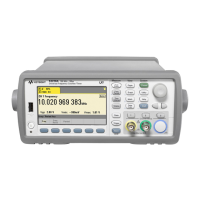R?
Syntax
R? [<max_count>]
Description
This command reads and erases measurements from reading memory up to the specified <max_count>.
The measurements are erased from memory starting with the oldest (not the most recent) measurement
first. The purpose of this command is to allow you to periodically remove measurements from memory
that would normally cause reading memory to overflow.
Parameters
Name Type Range of Values Default Value
<max_count> Numeric 1 to 1,000,000 Read and erase all stored measurements
Remarks
l You can read memory at any time using the R? command, even during a measurement.
l If no measurements are available or in progress, error -230,"Data corrupt or stale" will be generated,
and no data will be returned.
l This command differs from the DATA:REMove? command in that R? will read and erase whatever meas-
urements are available in reading memory, up to the specified <max_count>. DATA:REMove will error if
the requested number of measurements are not in reading memory when the command is sent.
l You can store up to 1,000,000 measurements in the reading memory. If memory overflows, the new
measurements will overwrite the first (oldest) measurements stored; the most recent measurements are
always preserved. No error is generated, but the Reading Mem Ovfl bit (bit 14) is set in the Questionable
Data Register.
l The instrument clears all measurements from memory when the measurement function is changed,
when the INITiate:IMMediate, MEASure:<function>? or READ? commands are executed, after a Factory
Reset (*RST command) or after an Instrument Preset (SYSTem:PRESet command).
Return Format
The command returns a series of measurements in Definite-Length Block format. The syntax is a pound
sign (#) followed by a non-zero digit representing the number of digits in the decimal integer to follow.
This digit is followed by a decimal integer indicating the number of 8-bit data bytes to follow. This is fol-
lowed by a block of data containing the specified number of bytes. The return format is determined by the
FORMat Subsystem commands.
For timestamp measurements, the command returns the prescaler value followed by a comma, followed
by the measurements. The prescaler value is always returned in the format: +100. The measurements
are returned in the Definite-Length Block format described above.
R?
26 Keysight 53220A/53230A Programmer's Reference

